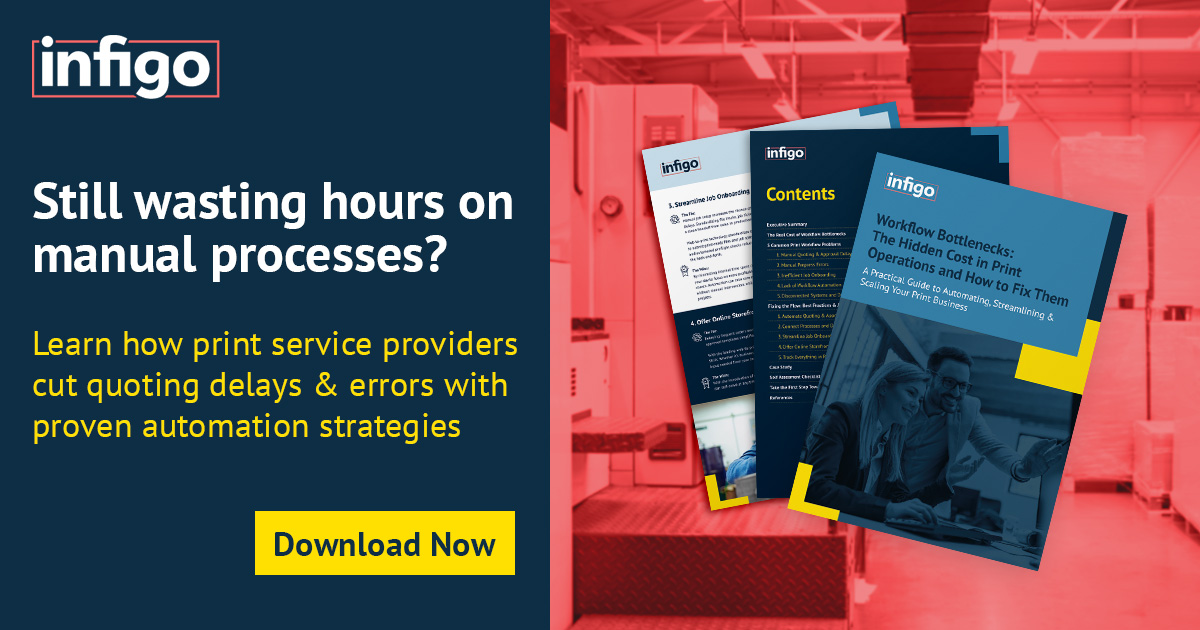The rules of the printing game have changed massively in recent years – which you’ve probably noticed. Customers’ expectations have changed dramatically, with a new generation of print buyers demanding intuitive experiences, similar to the other platforms and apps they use on a daily basis – from Amazon to Uber.
When orders get stuck in the system, proofs take days instead of hours, or assets are hard to find, the entire client experience suffers, which means lost business in the future.
To remain competitive, the modern commercial print shop needs to:
- Deliver a higher volume of print
- Deliver it quicker than ever before
- All without compromising on quality
But streamlining production doesn’t mean overhauling your entire infrastructure. Small, tactical changes can make a big difference in days rather than months.
Below, we explore five improvements that you can start putting into action right away, to massively improve your primary production workflow.
1. Automate the Proofing Process
Manual proofing has always been one of the silent killers of efficiency. Chasing sign-offs over long email chains, working with out-of-date file versions, or spotting last-minute errors often causes avoidable delays.
What should be a quick approval can turn into days of back-and-forth, and in a competitive market, that’s a risk you can’t afford.
By introducing a digital proofing tool (often built directly into a modern web-to-print platform) you can automate this process almost overnight. Files are uploaded once, comments and revisions are managed in one central place, and version control is automatic.
Instead of juggling email attachments, your client sees a single link and can approve or amend directly within the system.
This simple shift speeds up approvals dramatically. Projects that used to take days to get signed off can now be approved in hours.
- Eliminate delays caused by endless email chains and outdated file versions by centralising feedback and approvals in one streamlined system.
- Automate proofing with digital tools that manage revisions, track changes, and keep everyone on the same (correct) version.
- Speed up sign-offs and reduce errors, giving your team more time to produce—and your clients more reasons to stick around.
2. Standardize File Submission with Smart Templates
Another area where time is routinely lost is in the pre-press stage. Inconsistent file formats, low-resolution images, and artwork that doesn’t meet specifications can all create unnecessary bottlenecks. Every minute your team spends adjusting client files is time they could spend producing new work.
One way to remove this friction is to create branded, pre-set templates for frequently ordered products. These templates guide clients to supply files that meet your exact requirements, from resolution and bleed to safe zones. Rather than fixing problems downstream, you prevent them upstream.
Once this becomes the norm, you’ll notice a transformation in how smoothly jobs move through production. Instead of spending hours correcting files, your team can take artwork straight to press. The quality becomes consistent, and you’ll find that deadlines become far easier to meet. The client experience also improves because their files look professional every single time.
- Pre-press delays often stem from inconsistent file quality, costing your team valuable production time on preventable fixes.
- Branded, pre-set templates help clients submit artwork that meets your specs, reducing errors before they happen.
- With clean files arriving press-ready, jobs move faster, quality stays high, and client satisfaction goes up.
3. Introduce Real-Time Job Tracking
One of the most common frustrations in print production (for both clients and your business) is a lack of visibility. When clients are unsure about the status of their job, they pick up the phone or fire over an email.
When whoever picks up the phone doesn’t have instant answers, they have to stop what they’re doing to check, which slows everyone down.
Introducing real-time job tracking changes this dynamic completely. By using a dashboard that updates automatically at every stage—submission, pre-press, printing, finishing, dispatch—you give both your team and your customers a clear view of progress. Clients can log in and see exactly what’s happening, while your team stays focused on the job at hand.
The result is a huge reduction in “where’s my order?” queries. It also builds trust. When customers see that you’re transparent, they gain confidence in your process and are more likely to return. For your team, it eliminates a big administrative headache and keeps production moving without costly interruptions.
- Lack of job visibility leads to constant client check-ins, disrupting your team and draining productivity.
- Real-time tracking dashboards give clients instant updates, reducing the need for calls and emails while building trust.
- With fewer interruptions, your team stays focused, workflows run smoother, and customers feel confident in your process.
4. Centralize Asset Management
How often do your clients (or even worse, a member of your team) find themselves unnecessarily hunting through email attachments, shared drives and old folders looking for the right logo, the latest artwork, or approved brand guidelines?
Disorganized assets cost time and create risk.
A cloud-based asset library solves this problem at the root. By storing individual clients’ assets in one place (with proper naming, version control and permissions) you create a single source of truth. Everyone knows exactly where to find what they need, and no one wastes hours digging through old files.
Centralization does more than speed things up. It ensures that the work you produce for clients is consistent, massively reducing errors and wasted resources. Over time, this small but powerful change becomes one of the foundations of a smooth, efficient production workflow.
- Wasting time searching for the right assets slows everyone down and increases the risk of using outdated or incorrect files.
- A cloud-based asset library keeps client files organised and accessible, with version control, naming conventions and permissions all in place.
- Centralizing assets ensures brand consistency, reduces errors, and lays the groundwork for a more efficient, scalable workflow.
5. Streamline Reorders with Web-to-Print Portals
For many print businesses, repeat orders make up a significant portion of revenue. Yet it’s surprising how much time and energy is still spent managing these manually. Every repeat order requires new emails, new proofs, and new job setup, even when nothing has changed.
A web-to-print portal can transform this part of your business. By allowing clients to place repeat orders themselves, through a branded portal, the process becomes effortless. Their specifications are stored, their previous orders can be selected with a click, and no one has to reinvent the wheel.
The turnaround time for these jobs shrinks dramatically.
What once took days of admin can be processed in minutes. For your clients, it’s a smooth, self-service experience that keeps them coming back. For your team, it’s an opportunity to focus on more complex and creative work rather than repetitive admin.
- Repeat orders often create unnecessary admin, with teams redoing work for jobs that haven’t changed.
- A web-to-print portal lets clients place reorders themselves, using saved specs and previous jobs for instant turnaround.
- The result is faster fulfilment, improved client experience, and more time for your team to focus on higher-value work.
Small Changes, Big Impact
What’s striking about these improvements is that none of them require huge investment or complex change management. They’re straightforward, low-barrier upgrades that deliver measurable results—faster workflows, happier clients, and more capacity to take on new work.
In a market where speed, accuracy and reliability define who wins the job, the difference between manual and automated workflows is more significant than ever.
Ready to Transform Your Workflow?
These five ideas are just the beginning. With the right web-to-print platform, you can connect every part of your print production workflow, automate repetitive tasks, and create a seamless experience that benefits both your team and your clients.
To learn how Infigo could transform your workflows, download our guide Workflow Bottlenecks: The Hidden Cost in Print Operations and How to Fix Them now.





